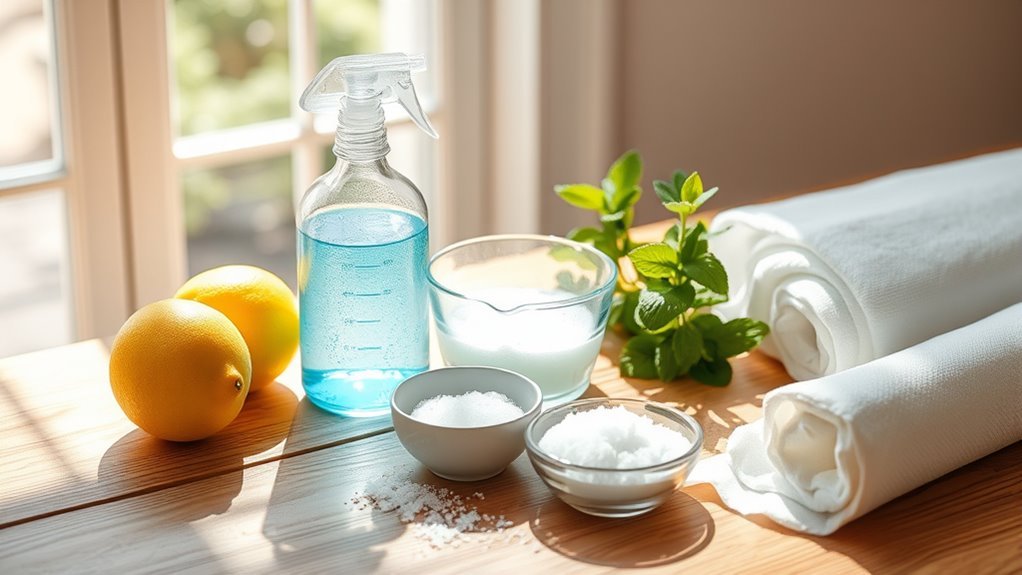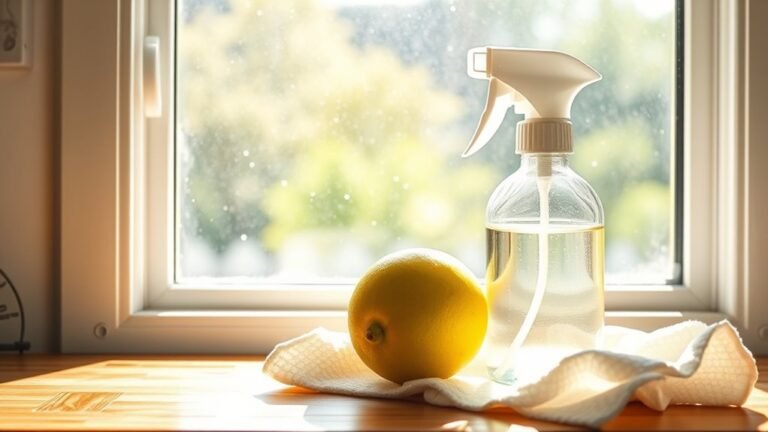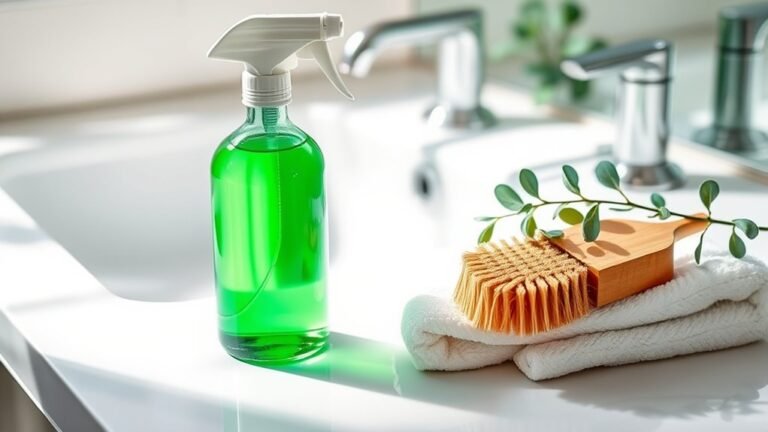DIY Cleaner for School Bag Surfaces
You can make a simple, eco-friendly cleaner using distilled water, white vinegar, and a bit of mild soap in a spray bottle. Test it on a small area of your school bag first to avoid damage. For fabric bags, spot clean gently; for leather, use a soft cloth and be certain to condition afterward. Synthetic bags can handle mild detergents. Regular wiping keeps your bag fresh, and proper storage of your cleaner guarantees safety. Discover how to tailor cleaning techniques for every bag type.
Materials Needed for Homemade Cleaner

To make your own cleaner for school bags, you’ll need just a few simple materials that are easy to find at home or in stores. Start with sustainable ingredients like white vinegar and baking soda, both effective and eco friendly options. Distilled water is crucial to dilute the mixture without introducing impurities. A mild liquid soap, preferably biodegradable, complements the blend for added cleaning power. You’ll also need a spray bottle for easy application and a soft cloth or sponge for gentle scrubbing. These materials guarantee your cleaner is safe for the environment and your bag’s surface. By choosing sustainable ingredients, you reduce waste and harmful chemicals. This approach supports your desire for freedom from commercial products loaded with toxins, giving you control over what touches your belongings.
Choosing the Right Ingredients for Your Bag Type
You’ll want to pick cleaning ingredients that match your bag’s material to avoid damage. For example, leather needs gentle, oil-based cleaners, while fabric bags respond well to mild detergents. Using safe, material-specific agents guarantees your bag stays clean without losing its shape or color.
Material-Specific Cleaning Agents
Different bag materials demand specific cleaning agents to avoid damage and guarantee effectiveness. For canvas or fabric bags, you’ll want gentle, eco friendly alternatives like diluted vinegar or mild soap, which tackle stains without harsh chemicals. Leather requires special care; use a leather-specific cleaner or a mix of water and a small amount of castile soap to preserve its texture. Synthetic bags can handle a bit more moisture, so mild detergents work well for stain removal techniques here. Avoid bleach or abrasive agents on any material—they risk discoloration or weakening fibers. By selecting the right cleaning agent tailored to your bag’s material, you maintain its look and durability while embracing greener, safer options. This approach guarantees your bag stays fresh and ready, without compromising your values or freedom to choose.
Safe Ingredients for Fabrics
Knowing which cleaning agents suit your bag’s material is only part of the equation; selecting safe ingredients guarantees your bag stays clean without causing harm to the fabric or your health. When choosing ingredients, lean toward natural alternatives like white vinegar, baking soda, or castile soap. These eco friendly solutions are gentle yet effective, reducing the risk of fabric damage or allergic reactions. For delicate fabrics like leather or suede, avoid harsh chemicals and opt for mild, plant-based oils or cleaners specifically designed for those materials. Always test your DIY cleaner on a small, hidden area first to verify it won’t discolor or weaken the fabric. By picking safe, natural ingredients tailored to your bag’s type, you maintain both its durability and your freedom to clean worry-free.
Step-by-Step Guide to Making the DIY Cleaner

You’ll need a few essential ingredients to make an effective DIY cleaner tailored for your school bag’s material. Follow clear mixing instructions to combine them properly for the best results. Finally, apply the cleaner safely to avoid damage and guarantee a thorough clean.
Essential Ingredients Needed
Gathering the right ingredients is key to making an effective DIY cleaner for school bags. You’ll want to choose simple, eco friendly options that deliver strong cleaning effectiveness without harsh chemicals. Start with distilled water as your base to avoid impurities. Add white vinegar, a natural disinfectant that breaks down grime and odors. Include a small amount of liquid castile soap, which gently lifts dirt without damaging fabric or hardware. To boost cleaning power and freshness, a few drops of essential oils like tea tree or lemon work well. These ingredients combine to create a safe, powerful cleaner that respects both your bag’s material and the environment. With these essentials on hand, you’re ready to mix a solution that keeps your school bag fresh and free from buildup.
Mixing Instructions Detailed
Start by measuring one cup of distilled water into a clean spray bottle. Next, add two tablespoons of white vinegar, an effective eco friendly option that tackles dirt without harsh chemicals. Then, mix in one teaspoon of liquid castile soap, which boosts cleaning power while remaining gentle on surfaces. Screw the spray top on tightly and shake gently to combine. Your DIY cleaner is now ready for use. Remember, regular cleaning frequency is key—wipe down your school bag surfaces at least once a week to keep grime at bay. This simple recipe balances effectiveness with environmental responsibility, giving you freedom from commercial products laden with toxins. Keep this solution handy for quick, safe refreshes that protect both your belongings and the planet.
Safe Application Tips
Once your DIY cleaner is prepared, applying it safely guarantees the best results without damaging your school bag. To keep your bag fresh and in great shape, follow these eco-friendly options and safe steps:
- Test a small, hidden area first to check for colorfastness or material reaction. This precaution helps avoid unwanted damage.
- Use a soft cloth or sponge dampened with the cleaner. Avoid soaking the surface; too much moisture can weaken adhesives or fabric.
- Wipe gently and evenly, then let the bag air dry completely before use. Stick to a cleaning frequency of once every two weeks or as needed to maintain cleanliness without overdoing it.
These steps verify your DIY cleaner works effectively while protecting your school bag’s lifespan.
How to Test the Cleaner on Different Surfaces

How can you be certain your DIY cleaner is safe for all parts of your school bag? Start by checking surface compatibility. Different materials—like leather, plastic, or canvas—react uniquely to cleaning solutions. To avoid damage, always perform a test patch on an inconspicuous area. Apply a small amount of cleaner, wait a few minutes, then observe any discoloration, texture change, or residue. If the test patch shows no adverse effects, proceed with confidence. Repeat this step for each distinct surface type on your bag to guarantee overall safety. Testing this way gives you control and freedom to clean effectively without risking damage, making your DIY cleaner a reliable choice for your school bag’s diverse surfaces.
Techniques for Cleaning Fabric School Bags
After confirming your cleaner is safe for each surface, you can focus on fabric school bags, which often require gentle care to maintain their appearance and durability. To effectively clean these bags while preserving fabric integrity, try these techniques:
- Spot Clean Stains: Apply your DIY cleaner directly to stains and gently blot with a soft cloth. Avoid rubbing, which can damage fibers.
- Hand Wash Delicately: Fill a basin with lukewarm water and mild detergent. Submerge the bag briefly, then rinse thoroughly to prevent residue buildup.
- Air Dry Naturally: Avoid heat sources; instead, hang your bag in a well-ventilated area to maintain shape and prevent fabric shrinkage.
These steps support fabric care and efficient stain removal, helping your school bag stay fresh without harsh chemicals or damage.
Methods for Cleaning Leather and Faux Leather Bags
Although leather and faux leather school bags require different care than fabric ones, cleaning them properly is just as important to preserve their look and longevity. For leather care, use a damp cloth with mild soap, then condition with a leather conditioner to keep it supple. Faux leather can be wiped with a mixture of water and gentle detergent, avoiding harsh chemicals that may damage the surface. Always test any cleaner on a small area first.
| Material | Cleaning Agent | Key Tip |
|---|---|---|
| Leather | Mild soap & water | Condition after cleaning |
| Faux Leather | Water & gentle detergent | Avoid harsh chemicals |
| Both | Soft cloth | Test cleaner on small spot |
| Both | Air dry naturally | Avoid direct sunlight |
Follow these steps to maintain your bag’s freedom to look great!
Tips for Cleaning Synthetic and Nylon Bag Surfaces
Leather and faux leather bags need special care, but synthetic and nylon bags call for a different approach. To keep your bag looking fresh and extend its life, manage cleaning frequency wisely and focus on stain prevention.
- Spot Clean Quickly: Address spills immediately using a damp cloth with mild soap to prevent stains from setting into nylon fibers.
- Gentle Washing: For a deeper clean, hand wash with lukewarm water and gentle detergent, avoiding harsh scrubbing that can damage synthetic material.
- Air Dry Thoroughly: Always let your bag air dry in a well-ventilated area away from direct sunlight to prevent material degradation.
Best Practices for Maintaining Clean Bags Daily
Maintaining your school bag’s cleanliness daily can save you time and effort in the long run. By adopting simple daily habits, you keep dirt and clutter at bay, making your bag last longer and stay fresh. Focus on bag organization by emptying unnecessary items and wiping surfaces regularly.
| Daily Habits | Bag Organization |
|---|---|
| Empty your bag nightly | Sort items by category |
| Spot-clean stains ASAP | Use pouches for small items |
| Air out your bag daily | Arrange essentials upfront |
Stick to these routines, and your bag will remain neat without extra hassle. These practices give you freedom from deep cleaning sessions and guarantee your bag looks great every day. Simple, consistent care is the key to a clean, organized school bag.
Storage and Safety Tips for Your Homemade Cleaner
Keeping your school bag clean with a homemade cleaner is effective, but storing and handling your solution properly guarantees safety and long-lasting use. Here are essential storage tips and safety precautions to keep in mind:
- Store your cleaner in a clearly labeled, airtight container to prevent spills and contamination. Avoid repurposing food containers to reduce accidental ingestion risks.
- Keep the cleaner out of reach of children and pets, ideally in a locked cabinet or high shelf, ensuring no accidental exposure occurs.
- Always store your cleaner in a cool, dry place away from direct sunlight or heat sources to maintain its effectiveness and prevent chemical breakdown.
Häufig gestellte Fragen
Can This Cleaner Remove Tough Stains Like Ink or Paint?
You can tackle tough stains like ink and paint with the right approach. For ink stain removal, applying a bit of rubbing alcohol or hand sanitizer often works well. Paint stain solutions might require gentle scrubbing with a mix of dish soap and warm water. Remember, test a small area first to avoid damage. With these tricks, you’ll have the freedom to clean your bag effectively without harsh chemicals or expensive products.
How Often Should I Deep Clean My School Bag?
How often should you deep clean your school bag? Think of it like a garden—neglect it, and dirt takes over. Frequency guidelines suggest a deep clean every 1-2 months, depending on use and exposure. Establish a cleaning schedule that fits your routine, balancing freshness with freedom. Regular spot cleaning can extend time between deep cleans, keeping your bag ready for anything without feeling like a chore.
Is This DIY Cleaner Safe for Children’s Skin?
You’ll want to prioritize child safety when using any cleaner near kids. This DIY cleaner is generally safe, but you should still test a small skin patch first to avoid skin irritation. It’s made from gentle, natural ingredients, reducing harsh chemical risks. Always rinse the bag thoroughly and let it dry before use. Taking these precautions helps keep your child’s skin safe while enjoying a cleaner bag.
Can the Cleaner Be Used on Bag Zippers and Hardware?
Imagine your bag’s zippers and hardware shining like tiny, polished jewels. Yes, you can use the cleaner on them, but with gentle cleaning techniques—dab lightly and avoid soaking to protect the metal parts. For zipper care, a soft cloth paired with this cleaner keeps them smooth and rust-free, extending their life. This approach lets you maintain freedom from grime without harsh abrasion, preserving both function and flair.
How Long Does the Homemade Cleaner Stay Effective After Mixing?
The shelf life of your homemade cleaner is usually about one to two weeks. To keep it effective, store it in a cool, dark place, ideally in a sealed spray bottle to prevent contamination. Avoid leaving it in direct sunlight or warm areas, as this can degrade its ingredients faster. If you notice any changes in smell or appearance, it’s best to mix a fresh batch to maintain cleaning power.






